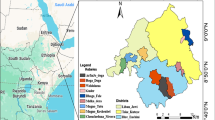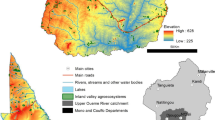Abstract
We investigated the effects of changing land use on water yield, and nitrogen (N) and sediment retentions in the Teshio river watershed in northern Japan. The Land Use and it’s Effects (CLUE) model was used to predict land use change and multilevel Bayesian analysis was used to quantify relationships between water quality components and topographical slope. The Soil and Water Assessment Tool (SWAT) hydrology model was used to simulate water yield, N and sediment retentions under land use change scenarios. Most of the study area was covered by forest in 1976, 2006 and 2036, with rice fields totally converted to farmland by 2036. There were positive correlations between water yield, inorganic-N yield, sediment yield and organic-N yield and topographical slope, but there was negative correlation between nitrate nitrogen (NO3-N) in the bottom of soil profile and topographical slope. Sediment and organic-N yields of forest were less than those of other land uses. Water yield, organic-N and sediment retentions were largest in the southeast of the study watershed, while the inorganic-N retention was highest along the riverine area. In comparison with the 1976 land use pattern, water yield sediment retention and organic-N retention decreased under 2006 and 2036 land use patterns while inorganic-N retention increased. We conclude that planning a comprehensive adaptation and mitigation program (e.g. establishing riparian zones, planning nutrient management practices and integrating systematic conservation planning into agricultural expansion) is necessary to avoid negative impacts of land use change on water yield, N and sediment retentions in the watershed.






Similar content being viewed by others
References
Alibuyog NR, Ella VB, Reyes MR, Srinivasan R, Heatwole C, Dillaha T (2009) Predicting the effects of land use change on runoff and sediment yield in Manupali River sub-watersheds using the SWAT model. Int Agric Eng J 18:15–25
Arnold JG, Allen PM (1996) Estimating hydrologic budgets for three Illinois watersheds. J Hydrol 176:57–77
Balmford A, Bruner A, Cooper P et al (2002) Economic reasons for conserving wild nature. Science 297:950–953
Chaplot V, Saleh A, Jaynes DB, Arnold J (2003) Predicting water, sediment and NO3-N loads under scenarios of land-use and management practices in a flat watershed. Water Air Soil Pollut 154:271–293
Downing JA, Mcclain M, Twilley R et al (1999) The impact of accelerating land use change on the N-cycle of tropical aquatic ecosystems: current conditions and projected changes. Biogeochemistry 46:109–148
Ferrier RC, Whitehead PG, Sefton C, Edwards AC, Pugh K (1995) Modelling impacts of land use change and climate change on nitrate-nitrogen in the River Don, North East Scotland. Water Res 29(8):1950–1956
Fitzpatrick FA, Scudder BC, Lenz BN, Sullivan DJ (2001) Effects of multi-scale environmental characteristics on agricultural stream biota in eastern Wisconsin. J Am Water Resour Assoc 37:1489–1507
Foley JA, Defries R, Asner GP et al (2005) Global consequences of land use. Science 309:570–574
Ileva NY, Shibata H, Satoh F, Sasa K, Ueda H (2009) Relationship between the riverine nitrate-nitrogen concentration and the land use in the Teshio River watershed, North Japan. Sustain Sci 4:189–198
IPCC (2007) Climate change 2007: impacts, adaptation and vulnerability. In: Parry ML et al (eds) Contribution of working group ii to the fourth assessment report of the intergovernmental panel on climate change. Cambridge Univ Press, Cambridge
Johnes PJ, Heathwaite AL (1997) Modelling the impact of land use change on water quality in agricultural catchments. Hydrol Process 11:269–286
Katsuyama M, Shibata H, Yoshioka T, Yoshida T, Ogawa A, Ohte N (2009) Applications of a hydro-biogeochemical model and long-term simulations of the effects of logging in forested watersheds. Sustain Sci 4:189–198
Lenat DR, Crawford JK (1994) Effects of land use on water quality and aquatic biota of three North Carolina Piedmont streams. Hydrobiologia 294(3):185–200
Lin YP, Hong NM, Wu PJ, Wu CF, Verburg PH (2007) Impacts of land use changes scenarios on hydrology and land use patterns in the Wu-Tu watershed in Northern Taiwan. Landsc Urban Plan 80:111–126
Majumdar A, Kaye JP, Gries C, Hope D, Grimm N (2008) Hierarchical spatial modeling and prediction of multiple soil nutrients and carbon concentrations. Commun Stat Simul C 37:434–453
Marshall E, Randhir T (2008) Effects of climate change on watershed system: a regional analysis. Clim Chang 89:263–280
Metzger MJ, Rounsevell MDA, Michlik LA, Leemans R, Schröter D (2006) The vulnerability of ecosystem services to land use change. Agric. Ecosyst Environ 114:69–85
Metzger MJ, Schröter D, Leemans R, Cramer W (2008) A spatially explicit and quantitative vulnerability assessment of ecosystem service change in Europe. Reg Environ Chang 8:91–107
Mishima S (2001) Recent trend of nitrogen flow associated with agriculture production in Japan. Soil Sci Plant Nutr 47:157–166
Mishima S, Endo A, Kohyama K (2010) Nitrogen and phosphorus balance on crop production in Japan on national and prefectural scales. Nutr Cycl Agroecosyst 87:159–173
Nakakaawa CA, Vedeld PO, Aune JB (2011) Spatial and temporal land use and carbon stock changes in Uganda: implication for future REDD strategy. Mitig Adapt Strateg Glob Chang 16:25–62
Rodriguez JP, Beard TD Jr, Bennett EM et al (2006) Trade-offs across space, time, and ecosystem services. Ecol Soc 11(1):28
Thampi SG, Raneesh KY, Surya TV (2010) Influence of scale on SWAT model calibration for streamflow in a river basin in the humid tropics. Water Resour Manag 24:4567–4578
Tong STY, Chen WL (2002) Modeling the relationship between land use and surface water quality. J Environ Manag 66:377–393
Trisurat Y, Alkemade R, Verburg PH (2010) Projecting land-use change and its consequences for biodiversity in Northern Thailand. Environ Manag 45:626–639
Turner MG, Gardner RH, O’Neill RV (2001) Landscape ecology in theory and practice pattern and process. Springer, New York
Verburg PH, Soepboer W, Veldkamp A, Limpiada R, Espaldon V (2002) Modeling the spatial dynamics of regional land use: the CLUE-S model. Environ Manag 30:391–405
Webber DF, Mickelson SK, Ahmed SI, Russell JR, Powers WJ, Schultz RC, Kovar JL (2010) Livestock grazing and vegetation filter strip buffer effects on runoff sediment, nitrate, and phosphorus losses. J Soil Water Conserv 65:34–41
Zhao B, Kreuter U, Li B, Ma ZJ, Chen JK, Nakagoshi N (2004) An ecosystem service value assessment of land-use change on Chongming Island, China. Land Use Policy 21:139–148
Acknowledgments
This study was partly supported by a scholarship from the China Scholarship Council. The work was conducted under the Program for Risk Information on Climate Change, supported by the Ministry of Education, Culture, Sports, Science and Technology of Japan (MEXT).
Author information
Authors and Affiliations
Corresponding author
Electronic supplementary material
Below is the link to the electronic supplementary material.
Table ESM-1
(DOC 679 kb)
Table ESM-2
(DOC 679 kb)
Table ESM-3
(DOC 323 kb)
Table ESM-4
(DOC 318 kb)
Table ESM-5
(DOC 33 kb)
Table ESM-6
(DOC 33 kb)
Table ESM-7
(DOC 33 kb)
Table ESM-8
(DOC 33 kb)
Appendix
Appendix
This section contains electronic supplementary materials (ESMs) for the article, “Water yield, nitrogen and sediment retentions in northern Japan (Teshio river watershed)”. Parameter estimates of multilevel Bayesian regression predicting inorganic-N yield from slope, land use type and soil type was shown in a Table ESM-1. Parameter estimates of multilevel Bayesian regression predicting NO3-N in the bottom of soil profile from slope, land use type and soil type was shown in a Table ESM-2. Parameter estimates of multilevel Bayesian regression predicting sediment yield from slope, land use type and soil type was shown in a Table ESM-3. Parameter estimates of multilevel Bayesian regression predicting organic-N yield from slope, land use type and soil type was shown in a Table ESM-4. Multilevel Bayesian regression predicting inorganic-N yield from average slope, land use type and soil type was shown in a Table ESM-5. Multilevel Bayesian regression predicting NO3-N in the bottom of soil profile from average slope, land use type and soil type was shown in a Table ESM-6. Multilevel Bayesian regression predicting sediment yield from average slope, land use type and soil type was shown in a Table ESM-7. Multilevel Bayesian regression predicting organic-N yield from average slope, land use type and soil type was shown in a Table ESM-8.
Rights and permissions
About this article
Cite this article
Fan, M., Shibata, H. Water yield, nitrogen and sediment retentions in Northern Japan (Teshio river watershed): land use change scenario analysis. Mitig Adapt Strateg Glob Change 21, 119–133 (2016). https://doi.org/10.1007/s11027-014-9574-3
Received:
Accepted:
Published:
Issue Date:
DOI: https://doi.org/10.1007/s11027-014-9574-3




